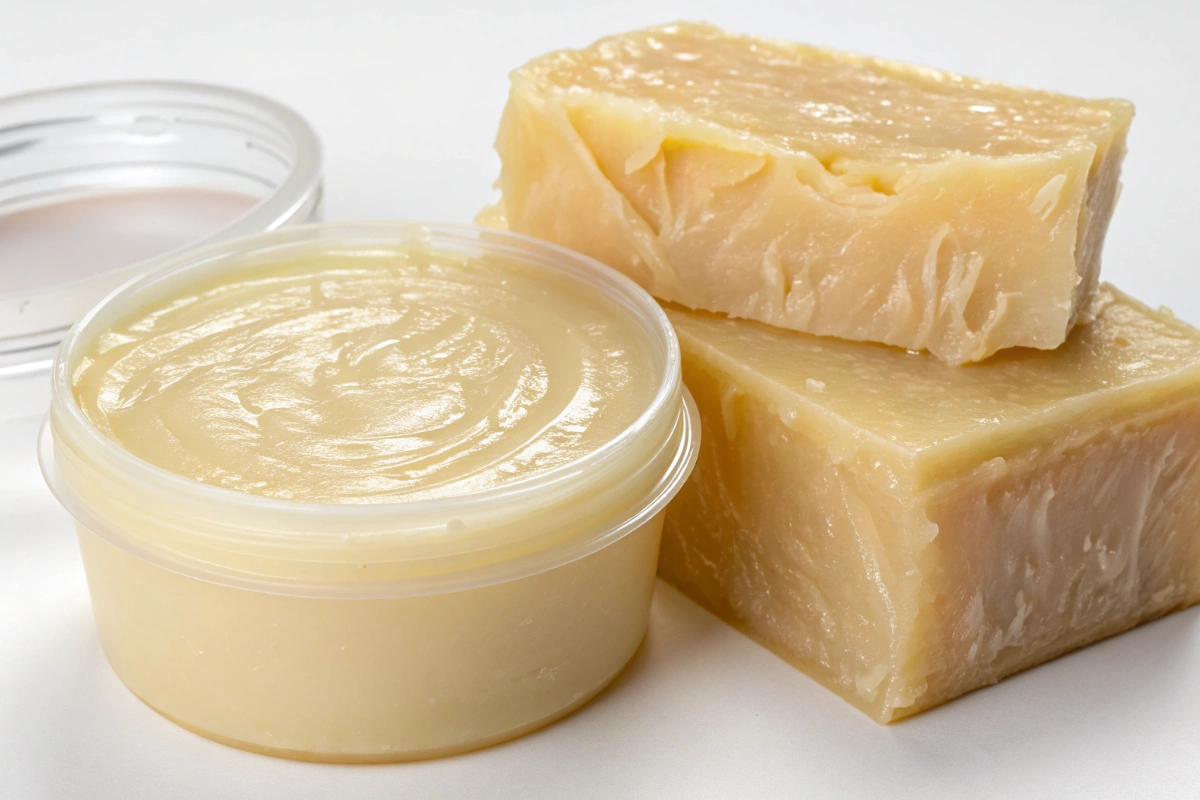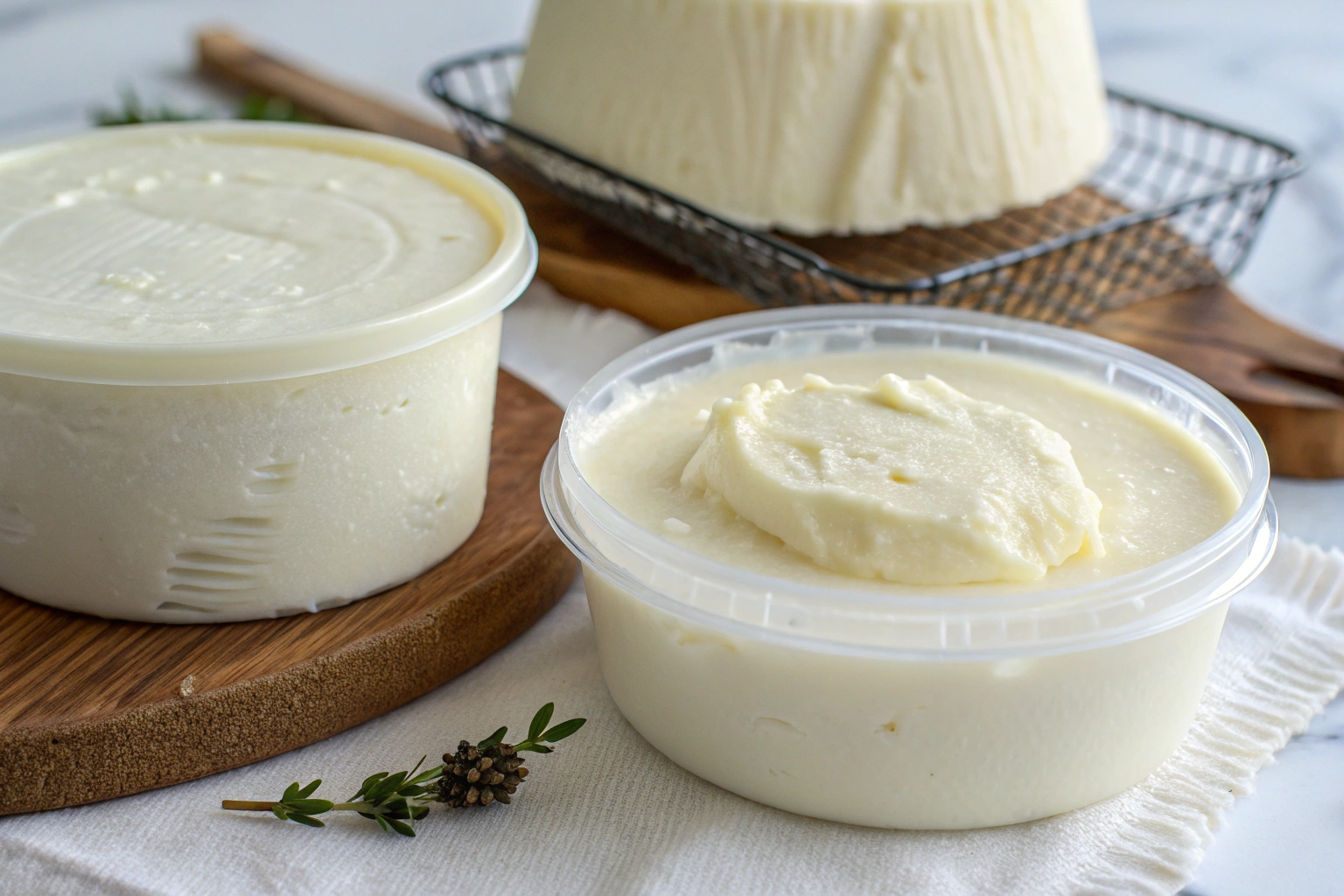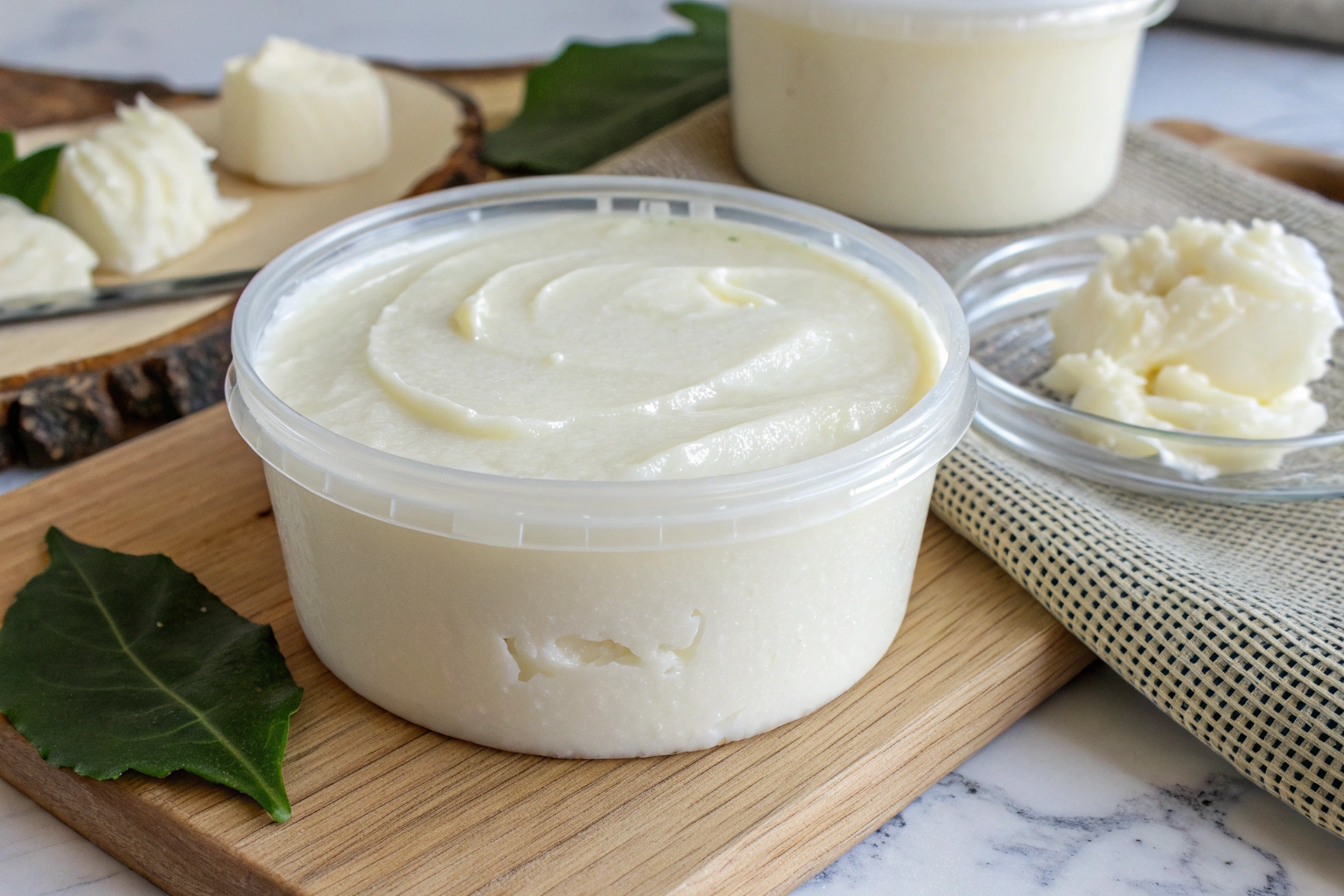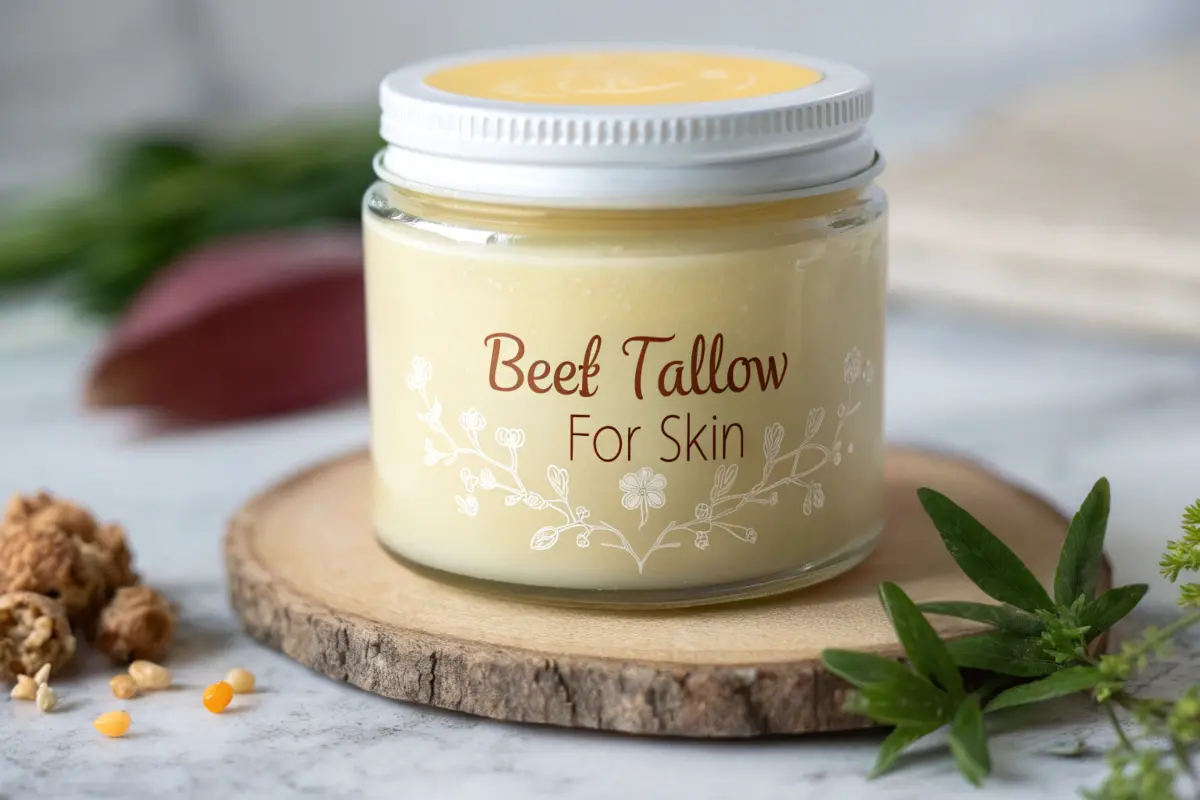Beef tallow for skin is rapidly gaining attention in the beauty and wellness industry. This age-old remedy, once commonly used in traditional skincare, has made a comeback as a powerful, all-natural option for maintaining healthy skin. But what exactly is beef tallow, and why is it so beneficial for your skin? Let’s explore the wonders of beef tallow, how it compares to other oils, and why it could become your new skincare staple.
What Is Beef Tallow?
Beef tallow is rendered beef fat, traditionally used for cooking, lighting, and skincare. This pure form of fat is rich in saturated fats and provides a valuable source of vitamins A, D, E, and K. These nutrients are essential for maintaining healthy skin, promoting cellular function, protecting from environmental damage, and improving the skin’s overall appearance.
Its Historical Use of in Skincare
Before modern synthetic skincare products emerged, many cultures relied on natural fats like beef tallow for skin care. For centuries, tallow was considered an important part of everyday routines, known for its ability to hydrate and nourish skin without harsh chemicals. With the rise of natural beauty products today, it is experiencing a resurgence for its safe and effective properties.
Nutritional Composition of Beef Tallow
Beef tallow consists mostly of saturated fats, which are excellent for sealing in moisture and creating a protective barrier on the skin. It also contains essential fatty acids like oleic acid and palmitic acid, which help maintain skin elasticity. These natural components, combined with vitamins A, D, E, and K, support skin regeneration and repair, making tallow a powerful ingredient for skincare.

Benefits of Beef Tallow for Skin
- Deep Moisturization and Hydration
Beef tallow excels at providing deep hydration for dry, flaky, or cracked skin. Its high-fat content forms a barrier that locks moisture into the skin, offering long-lasting hydration compared to commercial moisturizers that contain water as a main ingredient. Tallow is perfect for those seeking intensive moisture without the need for frequent reapplication. If you’re interested in more healthy meal options to complement your skincare routine, try exploring Healthy Cottage Cheese Recipes. - Anti-inflammatory Properties
Rich in anti-inflammatory properties, beef tallow helps soothe irritated skin. Whether dealing with redness, rashes, or conditions like eczema, tallow helps reduce inflammation and provides relief for sensitive skin. Its ability to nourish and repair makes it a go-to solution for calming troubled skin. For more skin-healing benefits, check out Marry Me Chicken Pasta Recipe. - Rich in Nutrients for Skin Health
Beef tallow contains vitamins A, D, E, and K, which are crucial for maintaining healthy skin. Vitamin A aids in cell turnover and regeneration, helping to reduce fine lines and wrinkles. Vitamin E serves as a potent antioxidant, fighting free radicals that contribute to aging. Together, these vitamins make it a natural, nutrient-packed option for radiant skin. For more nutrient-packed meals, explore Black Chicken. - Promotes Healing and Skin Regeneration
The regenerative properties of beef tallow make it highly beneficial for healing scars, cuts, and other skin abrasions. It promotes collagen production and reduces inflammation, helping to speed up the skin’s healing process. If you’re recovering from damaged skin, beef tallow can help restore and renew it more quickly. You may also be interested in our Healthy Cottage Cheese Recipes for a diet that supports healing.
By adding beef tallow to your skincare routine, you can enjoy a more natural, nutrient-dense approach to skincare. Its deep hydration, anti-inflammatory properties, and regenerative benefits make it an excellent choice for anyone looking to improve their skin’s health and appearance.
How to Use Beef Tallow for Skin
- Direct Application on Skin
The easiest way to use beef tallow is by applying it directly to your skin. Start by taking a small amount of tallow and warming it in your hands until it melts. Once melted, gently massage the tallow into your skin, paying special attention to dry or irritated areas. You’ll instantly feel the moisturizing effects, leaving your skin feeling nourished, soft, and smooth. - Mixing Beef Tallow with Essential Oils
For an enhanced skincare routine, consider blending beef tallow with your favorite essential oils. Lavender, tea tree, or frankincense essential oils complement tallow beautifully, boosting its soothing and healing properties. Simply mix a few drops of your chosen essential oil into the tallow before applying it to your skin for an aromatic, therapeutic experience. You can also try adding a dash of Marry Me Chicken Pasta Recipe to your routine for an all-around healthy lifestyle. - Making DIY Beef Tallow Skincare Products
Feeling creative? You can make your own skincare products using beef tallow as a base. From facial creams to body balms, tallow is a versatile ingredient in DIY skincare. Combine it with other natural ingredients like beeswax, coconut oil, or shea butter to create luxurious, all-natural products tailored to your skin’s needs
Beef Tallow vs Other Oils for Skin
1. Comparison with Coconut Oil
Coconut oil is another popular oil known for its moisturizing benefits, but how does it stack up against beef tallow? While coconut oil is rich in fatty acids and works well as a moisturizer, beef tallow offers higher levels of vitamins A and D, which are vital for skin regeneration and healing. Additionally, tallow’s thicker consistency makes it especially effective for very dry skin, offering more lasting hydration.
2. Comparison with Jojoba Oil
Jojoba oil is often used to balance oil production and soothe the skin. However, when compared to beef tallow, jojoba oil lacks the same nutrient density. Beef tallow’s rich vitamin content and essential fatty acids provide deeper hydration and more comprehensive skin benefits than jojoba oil, making it an excellent choice for those seeking more than just surface-level moisture.
3. Comparison with Shea Butter
Shea butter is a well-known moisturizer, but it doesn’t offer the same anti-inflammatory benefits as beef tallow. While both are excellent for dry skin, tallow’s higher vitamin content, particularly vitamins A and D, helps to promote skin regeneration, while also soothing irritation and inflammation more effectively than shea butter.
By incorporating beef tallow into your skincare routine, you can enjoy its deep hydration, healing properties, and rich nutrient profile, offering an all-natural solution for healthy, nourished skin. or regenerative properties that beef tallow does. While both are excellent for hydration, beef tallow is more effective at promoting skin repair, making it a better option for those with scar tissue or skin conditions like eczema.
Is Beef Tallow Safe for All Skin Types?

1. Beef Tallow for Sensitive Skin
It is generally safe for sensitive skin, thanks to its natural composition and lack of harsh chemicals. Its anti-inflammatory properties can help reduce redness and irritation, making it a gentle and soothing option for those with delicate skin. The fat in tallow works to restore the skin’s natural barrier, promoting calmness and hydration without causing irritation.
2. Beef Tallow for Acne-Prone Skin
If you have acne-prone skin, you might wonder whether beef tallow is a good option. Despite its rich, fatty consistency, beef tallow is non-comedogenic, meaning it won’t clog pores. In fact, its natural healing properties can help soothe inflammation and reduce scarring caused by breakouts. However, as with any new skincare product, it’s best to patch-test before using it on your entire face.
3. Beef Tallow for Dry and Aging Skin
Beef tallow is especially beneficial for dry or aging skin. Its high fat content acts as an excellent moisturizer, helping to lock in hydration and prevent moisture loss. Additionally, the vitamins A, D, and E in beef tallow support collagen production, improving skin elasticity and helping to reduce the appearance of fine lines and wrinkles, keeping your skin looking youthful and smooth.
Side Effects and Considerations
Although beef tallow is generally safe, it may not be suitable for everyone. Those with oily or acne-prone skin should use it sparingly, as the thick consistency may contribute to breakouts in some cases. Always perform a patch test before applying beef tallow to larger areas of the skin to ensure there is no allergic reaction or irritation. If you’re unsure, consult a dermatologist before incorporating tallow into your routine.
Where to Buy Quality Beef Tallow for Skin
You can find high-quality beef tallow at health food stores, online retailers, or specialty shops. When purchasing tallow, opt for grass-fed, organic options to ensure the product is free from harmful chemicals, hormones, or antibiotics. Look for minimally processed tallow to retain its natural vitamins and nutrients for maximum skincare benefits.

How to Store Beef Tallow for Skincare
Proper storage is key to maintaining the freshness and effectiveness of your beef tallow. Store it in a cool, dark place, away from direct sunlight, and ideally in a sealed glass container. Refrigeration is recommended to extend its shelf life. Always ensure that the container is clean and dry to prevent contamination and keep your tallow in optimal condition.
Beef Tallow for Skin in Different Climates
1. Use in Cold Weather
In colder climates, beef tallow is particularly beneficial. Its rich, thick texture creates a protective barrier on the skin, locking in moisture and shielding it from harsh winds and low temperatures. Tallow helps prevent dry patches, chapping, and irritation, making it an excellent winter skincare solution.
2. Use in Hot and Humid Climates
In hot and humid climates, beef tallow should be used sparingly, as it can feel heavy on the skin. While it provides excellent moisture, the thicker consistency may be too much for warmer weather. If you live in a hot environment, consider mixing beef tallow with lighter oils such as jojoba or coconut oil to keep your skin moisturized without feeling greasy.
Beef Tallow in Traditional vs. Modern Skincare
1. Beef Tallow in Ancient Skincare Practices
Beef tallow has been used for centuries in skincare. Ancient Egyptians, for example, applied it to protect their skin from the sun and environmental stressors. Indigenous cultures also valued tallow for its ability to nourish and protect the skin, making it a staple in traditional beauty rituals across the globe.
2. Modern Trends and the Rise of Natural Skincare
Today, there is a growing movement toward natural skincare, and beef tallow is making a strong comeback. Many people are turning to natural ingredients like tallow to avoid the synthetic chemicals and toxins found in modern skincare products. With its nourishing properties and minimal processing, beef tallow is becoming a top choice for those seeking sustainable, eco-friendly skincare solutions.
By understanding the different uses and benefits of beef tallow, as well as considering your skin type and climate, you can make an informed decision about incorporating this powerful, natural ingredient into your skincare routine. Whether you’re dealing with dry, sensitive, or aging skin, beef tallow offers a rich, nutrient-dense solution for healthy, radiant skin.

FAQs
1. Is beef tallow good for your skin?
Yes, beef tallow is great for your skin. It’s rich in essential vitamins and fatty acids that moisturize, soothe inflammation, and promote skin healing.
2. Is tallow better than retinol?
Tallow and retinol serve different purposes. Tallow is excellent for hydration and nourishment, while retinol is effective for cell turnover and anti-aging. They can complement each other rather than being direct alternatives.
3. Is beef tallow halal for skin?
Yes, beef tallow can be halal for skincare, provided it comes from a halal source and is processed according to halal guidelines.
4. How long does it take for beef tallow to improve skin?
Results vary, but generally, you may start noticing improvements in skin hydration and texture within a few days to weeks of regular use. Full benefits may take a few months.
5. Is Beef Tallow Better Than Shea Butter?
- Beef Tallow: Known for its high levels of vitamins A and D, beef tallow is ideal for deep hydration, skin regeneration, and healing.
- Shea Butter: Lighter and more versatile, shea butter provides excellent moisture without being too heavy, making it suitable for all skin types.
6. How Unhealthy Is Beef Tallow?
Beef tallow contains a high level of saturated fats, which can be unhealthy if consumed in large amounts. This may contribute to raised cholesterol levels and increased risk of heart disease, so it should be used in moderation.
7. Does Beef Tallow Clog Pores?
Beef tallow is generally considered non-comedogenic, meaning it doesn’t clog pores for most skin types. However, it may cause breakouts for individuals with oily or acne-prone skin due to its thicker consistency.
Conclusion
Beef tallow for skin offers a wide range of benefits, from deep hydration to promoting skin regeneration. Whether you’re dealing with dry, sensitive, or aging skin, tallow can effectively nourish and protect your skin thanks to its rich, natural nutrients. Moreover, with a long history of use in traditional skincare and proven effectiveness in modern times, beef tallow may be the natural skincare solution you’ve been seeking. Additionally, its ability to moisturize, heal, and restore makes it a standout choice for anyone looking to enhance their skincare routine with a time-tested, all-natural ingredient. Consequently, it is more than just a skincare trend; it’s a powerful ally for maintaining healthy, vibrant skin.
Try it for yourself! Explore high-quality, pure beef tallow products, or even make your own at home. Experience the benefits firsthand and embrace a skincare routine that is both natural and effective. Your skin deserves the best!


2 thoughts on “Beef Tallow for Skin: Benefits, Uses, and the Secret to a Radiant Glow”